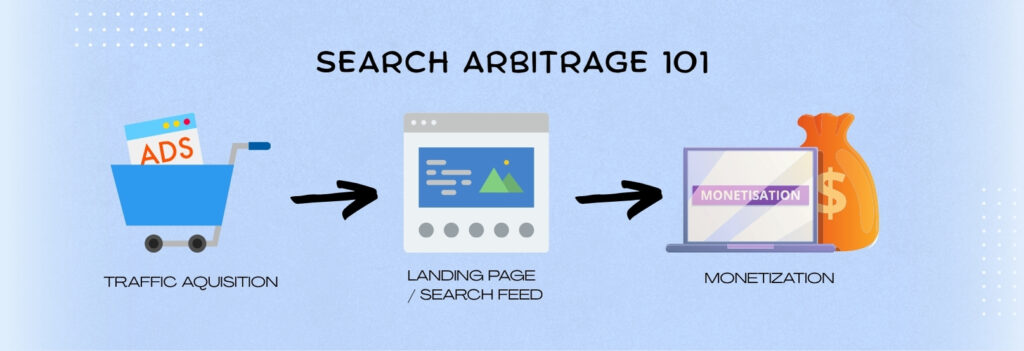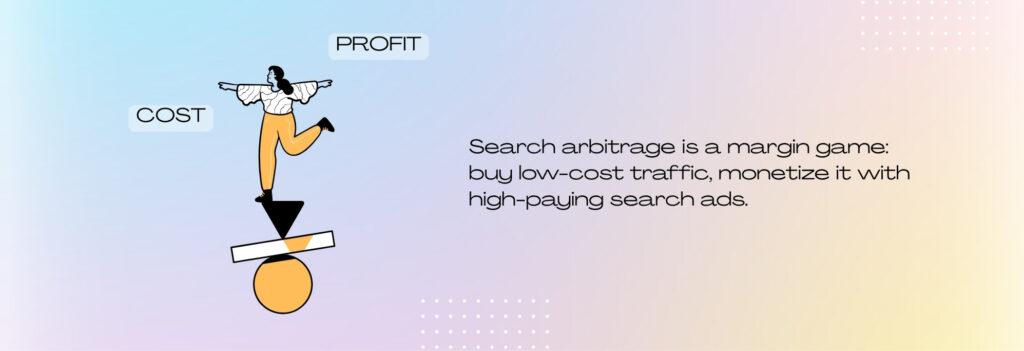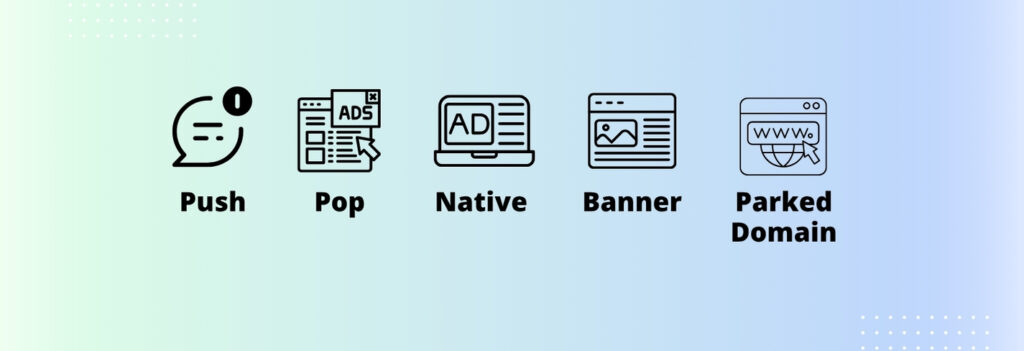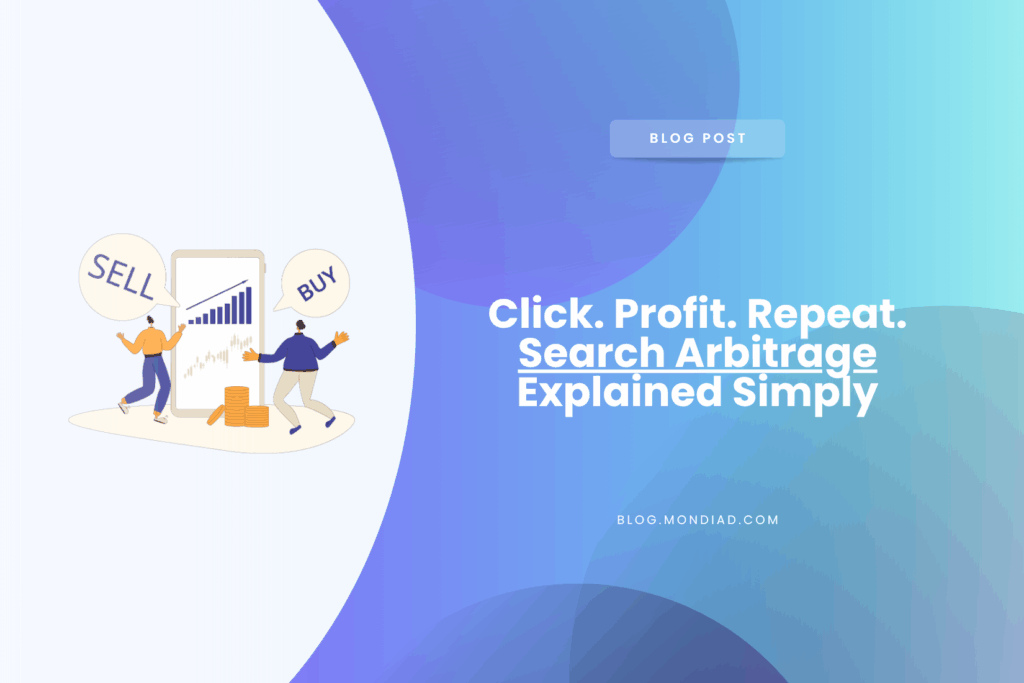Is Search Arbitrage Still Relevant? Yes, but it’s more competitive and regulated than ever. Big players dominate this space, and search engines closely monitor arbitrage practices to ensure they deliver user value.

What Is Search Arbitrage?
Search arbitrage is a media buying strategy where marketers purchase traffic from one source (typically at a low cost) and redirect it to a page monetized through high-paying search ads, usually from major search engines like Google, Bing, or Yahoo.
The goal is to profit from the difference between the cost of traffic and the revenue generated from ad clicks.

1. Traffic Acquisition
The arbitrager buys inexpensive traffic from ad networks, social media, push, native, or pop sources.
2. Redirect to a Landing/Search Page
This traffic lands on a page filled with sponsored search results or keyword-targeted search ads. These are often search result pages created to resemble traditional search engine results.
Paid search traffic is generated through pay-per-click (PPC) campaigns on search engines like Google Ads and Bing Ads. When you bid on specific keywords, your ads appear in the search engine results pages (SERPs) when users search for those keywords.
3. Monetization via Search Ads
When users click on the search ads, the page owner earns a payout from the search ad provider (e.g., Google AdSense for Search or Yahoo/Bing syndicated search partners).
4. Profit Margin
Arbitrageurs get paid per click (CPC) when users click on ads on the search result page. The difference between what the arbitrager paid for the traffic and what they earned from the search ads is the profit.

In simple terms: Buy low-cost traffic → Send it to a page full of search ads → Earn revenue from ad clicks → Keep the difference.
Example Scenario
- You buy 1,000 visitors via push ads for $10 ($0.01 per visitor).
- Out of those, 100 click on the search ads on your landing page.
- Each click earns you $0.25.
- You make $25 in revenue.
- Your profit is $15.
When Did Search Arbitrage Start?
Search arbitrage first gained traction in the early 2000s, during the rise of Google AdSense and other contextual ad platforms. Back then, savvy digital marketers realized they could profit by buying cheap traffic (like banner or email ads) and sending it to ad-heavy landing pages.
As programmatic advertising evolved, so did the practice. In the 2010s, media buyers started using pop, push, native, and social traffic sources to fuel arbitrage campaigns. With real-time bidding (RTB) and smarter targeting, arbitrage became more data-driven and scalable, but also more competitive and regulated.
Then vs. Now:
| 2000s | 2020s |
|---|---|
| Cheap display traffic | Smarter sources like native, push, pop, and programmatic |
| Manual campaign management | Automated bidding & real-time optimization |
| Low competition | High saturation & stricter compliance |
| Simple monetized pages | Geo-targeted, intent-driven, high-quality templates |
| Direct access to AdSense | Partnerships with search feed resellers & aggregators |
Who Uses Search Arbitrage?
Search arbitrage is used by:
- Affiliates and media buyers looking for profitable, scalable traffic strategies.
- Ad arbitrage networks and domain monetization companies that specialize in monetizing type-in traffic or parked domains with search feeds.
- SEO publishers and content farms using organic or paid traffic to drive users to search-heavy content.
- Programmatic traders using large traffic volumes and algorithmic bidding to exploit margin opportunities.
While it’s still possible for small players to profit from arbitrage, success today often depends on volume, optimization tech, and partnerships with premium search feed providers.
Business Models in Search Arbitrage
Affiliates use several methods to drive traffic to monetized search results, each with varying levels of user engagement and targeting. Here are the main models:
-
Direct Flow: Users are sent directly from the ad to a monetized search results page. It’s fast but needs highly targeted traffic.
-
Pre-Lander Flow: Users land on a pre-lander first (e.g., a short article or teaser page) before being redirected to the search results. This helps pre-qualify traffic and can improve conversion rates.
-
Niche Feeds: Affiliates focus on specific verticals like Finance, Gaming, or Software to serve highly relevant search ads, improving user engagement and revenue potential.
-
Search Pages with Search Bars: Users interact with a search function on a site, and monetization happens through the search results they trigger.
-
Browser Extensions: Extensions change a user’s default search engine to a monetized feed, capturing long-term traffic passively.
Each model has its pros and cons depending on your traffic source, audience behavior, and monetization partner.
Types of Traffic Are Commonly Used in Search Arbitrage?
To make search arbitrage work, marketers need high-volume, low-cost traffic that can be redirected to monetized search result pages. Here are the most frequently used traffic types:

1. Popunder Traffic
Popunder ads open behind the main browser window, making them less intrusive while still delivering high volumes.
Why it works: Cheap CPMs, large scale, and high user flow make it ideal for arbitrage.
2. Push Notification Traffic
Push ads appear directly on a user’s device (desktop or mobile), resembling system alerts or updates.
Why it works: High CTRs and lower CPCs, especially when paired with broad GEO targeting.
3. Native Ads
These are ad placements that mimic content on websites or apps (e.g., “sponsored articles”).
Why it works: They attract curious users who are likely to engage with search content. Can be optimized by device, GEO, or interest.
4. Redirect/Domain Traffic
This comes from expired or parked domains that receive type-in traffic, redirected to monetized search pages.
Why it works: The intent is often high (brand, product, or service-related), and the monetization can be consistent if the domain portfolio is strong.
5. Email Traffic (less common today)
Email traffic used to be more popular for arbitrage, but it’s fallen out of favor due to deliverability issues and low engagement.
The best-performing traffic sources vary based on vertical, GEO, and the quality of your landing/search page.
What Makes Arbitrage Work?
Search arbitrage works best when:
- The incoming traffic is cheap and high-volume.
- The search ads on the landing page are high-value.
- Pages are optimized for user intent, so users are likely to engage with the ads.
- There is smart keyword targeting and compliance with search policies.
Key Takeaways

- Search arbitrage is a margin game: buy low-cost traffic, monetize it with high-paying search ads.
- Testing and optimization are critical to success.
- It requires deep knowledge of traffic sources, user behavior, and search ad networks.
- While the model has evolved, it still offers opportunities for those who know how to scale smartly and stay compliant.
- The model has been around since the early 2000s and has evolved into a highly competitive, tech-driven practice.
- While still profitable, success in today’s landscape depends on data, tools, and compliance.
What Are the Risks?
Unlike traditional ad buying, this approach demands a careful balance of cost, audience targeting, and user behavior analysis to ensure the traffic you purchase actually turns into profitable clicks.
- Policy compliance: Google and Bing have strict rules for partners monetizing search feeds. Low-quality or deceptive pages can lead to bans.
- Razor-thin margins: Without proper tracking and optimization, small losses can scale quickly.
- High testing costs: Running experiments to find the right traffic mix can be expensive.
- Traffic volatility: Cost fluctuations and click behavior can shift rapidly, requiring constant monitoring.
- Technical complexity: Managing campaigns at scale requires automation, tracking, and optimization tools.
- This model relies heavily on optimization, high CTR, and search engine policies.
- Search networks may ban accounts if traffic quality is low or cloaking is detected.
- Compliance and quality scores matter a lot for long-term success.
At Mondiad, we understand the value of diverse monetization strategies, including arbitrage. Whether you’re acquiring traffic or looking to monetize it, our platform offers a wide range of targeting options, verticals, and optimization tools to help you get the most out of every click.
Want to test a search arbitrage strategy? Get in touch with our team or start a campaign today.

